10.4 Where Does Intelligence Come From?
No one is born knowing calculus and no one has to be taught how to blink. Some things are learned, others are not. But almost all of the really interesting things about people are a joint product of the innate characteristics with which their genes have endowed them and of the experiences they have in the world. Intelligence is one of those really interesting things that is influenced both by nature and by nurture. Let us start with nature.
10.4.1 Genetic Influences on Intelligence
The notion that intelligence is “in the blood” has been with us for a long time. For example, in The Republic, the philosopher Plato suggested that some people are born to rule, others to be soldiers, and others to be tradesmen. But it was not until late in the nineteenth century that this suggestion became the subject of scientific inquiry. Sir Francis Galton was a half cousin of Charles Darwin, and his contributions to science ranged from meteorology to fingerprinting. Late in life, Galton (1869) became interested in the origins of intelligence. He did careful genealogical studies of eminent families and collected measurements from over 12 000 people that ranged from head size to the ability to discriminate tones. As the title of his book Hereditary Genius suggests, he concluded that intelligence was inherited. Was he right?
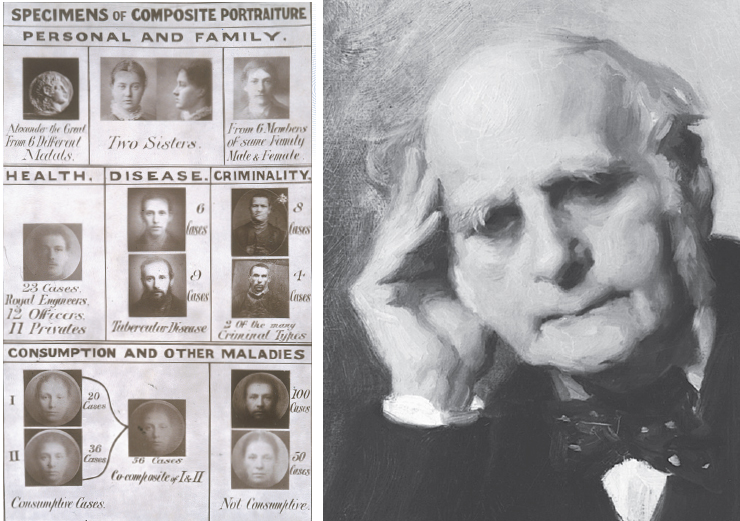
408
10.4.1.1 Studying Relatives
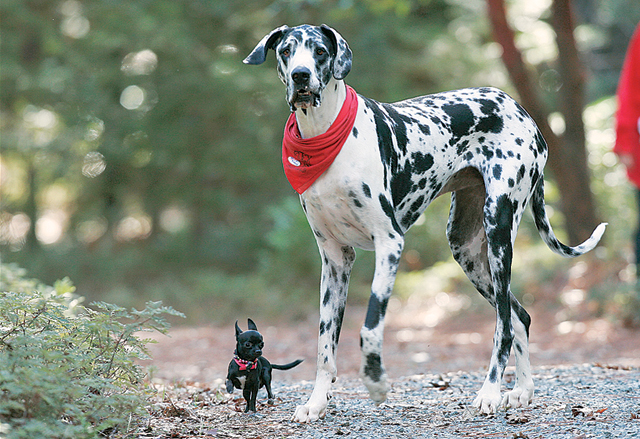
Why are the intelligence test scores of relatives so similar?
The fact that intelligence appears to “run in families” is not very good evidence of this genetic influence. After all, brothers and sisters share genes, but they share many other things as well. They typically grow up in the same house, go to the same schools, read many of the same books, and have many of the same friends. Members of a family may have similar levels of intelligence because they share genes, environments, or both. To separate the influence of genes and environments, we need to examine the intelligence test scores of people who share genes but not environments (e.g., biological siblings who are separated at birth and raised by different families), people who share environments but not genes (e.g., adopted siblings who are raised together), and people who share both (e.g., biological siblings who are raised together).
There are several kinds of siblings with different degrees of genetic relatedness. When siblings have the same biological parents but different birthdays, they share on average 50 percent of their genes. Fraternal twins (or dizygotic twins) develop from two different eggs that were fertilized by two different sperm, and although they happen to have the same birthday, they are merely siblings who shared a womb and they, too, share on average 50 percent of their genes. Identical twins (or monozygotic twins) develop from the splitting of a single egg that was fertilized by a single sperm, and unlike other siblings, they are genetic copies of each other, sharing nearly 100 percent of their genes. (Occasional mutations can affect one twin and not the other, so similarity is less than 100 percent.)
These different degrees of genetic relatedness allow psychologists to estimate the influence that genes have on intelligence. Studies show that the IQs of identical twins are strongly correlated when the twins are raised in the same household (r = 0.86), but they are also strongly correlated when the twins are separated at birth and raised in different households (r = 0.78). In fact, as you will notice from TABLE 10.3 (below), identical twins who are raised apart have more similar IQs than do fraternal twins who are raised together.

|
Relationship |
Shared Home? |
Shared Genes (%) |
Correlation between Intelligence Test Scores (r) |
|---|---|---|---|
|
Twins Identical twins (n = 4672) |
yes |
100 |
0.86 |
|
Identical twins (n = 93) |
no |
100 |
0.78 |
|
Fraternal twins (n = 5533) |
yes |
50 |
0.60 |
|
Parents and Children Parent– |
yes |
50 |
0.42 |
|
Parent– |
no |
50 |
0.24 |
|
Nonbiological parent– |
yes |
0 |
0.19 |
|
Siblings Biological siblings (2 parents in common) (n = 26 473) |
yes |
50 |
0.47 |
|
Nonbiological siblings (no parents in common) (n = 714) |
yes |
0 |
0.32 |
|
Biological siblings (2 parents in common) (n = 203) |
no |
50 |
0.24 |
|
Source: Plomin et al., 2001, p. 168. |
|||
What this means is that people who share all their genes have similar IQs regardless of whether they share their environments. Indeed, the correlation between the intelligence test scores of identical twins who have never met is about the same as the correlation between the intelligence test scores of a single person who has taken the test twice! By comparison, the intelligence test scores of unrelated people raised in the same household (e.g., two siblings, one or both of whom were adopted) are correlated only modestly, about r = 0.26 (Bouchard & McGue, 2003). These patterns of correlation suggest that genes play an important role in determining intelligence. This should not surprise us. Intelligence is, in part, a function of how the brain works, and given that brains are designed by genes, it would be quite remarkable if genes did not play a role in determining a person’s intelligence. Indeed, a mere 20 genes on a single chromosome are all that separates you from a person with Williams syndrome. Clearly, genes influence intelligence.
409
10.4.1.2 Heritability

But exactly how powerful is that influence? The heritability coefficient (commonly denoted as h2) is a statistic that describes the proportion of the difference among people in a given population that can be explained by differences in their genes. When the data from numerous studies of children and adults are analyzed together, the heritability of intelligence is roughly 0.5, which is to say that about 50 percent of the difference between people’s intelligence test scores is due to genetic differences between them (Plomin & Spinath, 2004; Plomin et al., 2013; cf. Chabris et al., 2012).
This fact may tempt you to conclude that half your intelligence is due to your genes and half is due to your experiences, but that is not right. To understand why, consider the rectangles in FIGURE 10.5. These rectangles clearly differ in size, and if you were asked to say what percentage of that difference was due to differences in the rectangles’ heights and what percentage was due to differences in the rectangles’ widths, you would correctly say that 100 percent of the difference in their sizes was due to differences in their widths and 0 percent was due to differences in their heights (which are, after all, identical). Good answer. Now, if you were asked to say how much of rectangle A’s size was due to its height and how much was due to its width, you would correctly say, “That’s a silly question.” It is a silly question because a rectangle’s size is a product of both its height and its width and it cannot be “due” to one more or less than the other.

410

Similarly, if you measured the intelligence of all the people at a hockey game and were then asked to say what percentage of the difference in their intelligences was due to differences in their genes and what percentage was due to differences in their experiences, you could reasonably guess that about 50 percent of the difference was due to each of these factors. That is what the heritability coefficient of 0.5 suggests. But if you were next asked to say how much of the intelligence of the annoying guy with the bad haircut in Row 17, Seat 4 was due to his genes and how much was due to his experiences, you could only reply, “That’s a silly question.” It is a silly question because the intelligence of a particular person is a joint product of both genes and experience—
Why is h2 higher among wealthy people than among poor people?
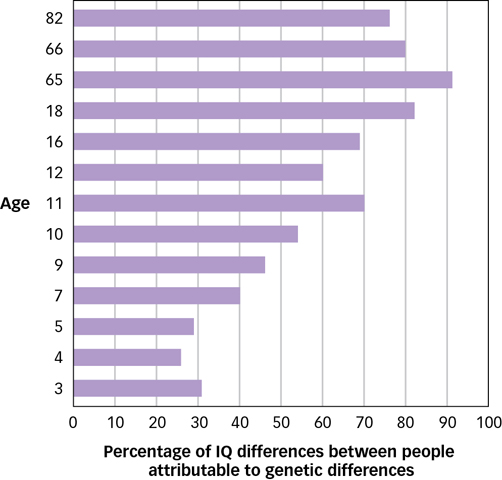
The heritability coefficient tells us why people in a particular group differ from one another; thus its value can change depending on the particular group of people we measure. For example, the heritability of intelligence among wealthy children is about 0.72 and among poor children about 0.10 (Turkheimer et al., 2003). How can that be? Well, if we assume that wealthy children have fairly similar environments—
411

Does this imply that in a science-
The appropriate conclusion [to draw from twin studies] is not so much that the family environment does not matter for development, but rather that the part of the family environment that is shared by siblings does not matter. What does matter is the individual environments of children, their peers, and the aspects of their parenting that they do not share.
10.4.2 Environmental Influences on Intelligence

In what ways is intelligence like height?
Canadians believe that every individual should have an equal chance to succeed in life, and one of the reasons why we bristle when we hear about genetic influences on intelligence is that we mistakenly believe that our genes are our destinies—
Is intelligence like height in this regard? Alfred Binet (1909) thought so:
A few modern philosophers…assert that an individual’s intelligence is a fixed quantity that cannot be increased. We must protest and react against this brutal pessimism.…With practice, training, and above all method, we manage to increase our attention, our memory, our judgment, and literally to become more intelligent than we were before.
It turns out that Binet was right. As FIGURE 10.7 shows, intelligence changes over time (Owens, 1966; Schaie, 1996, 2005; Schwartzman, Gold, & Andres, 1987). For most people, intelligence increases between adolescence and middle age and then declines thereafter. The sharpest decline occurs in old age (Kaufman, 2001; Salthouse, 1996a, 2000; Schaie, 2005), and may be due to a general slowing of the brain’s processing speed (Salthouse, 1996b; Zimprich & Martin, 2002). Age-
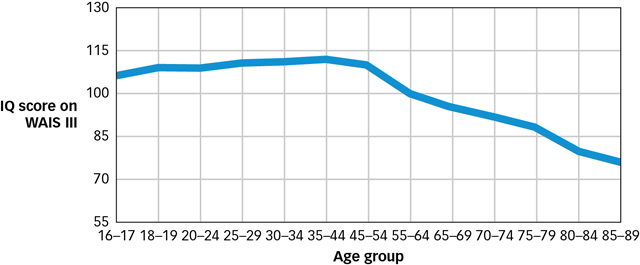
412

Not only does intelligence change over the life span, but it also changes over generations. The Flynn effect refers to the accidental discovery by James Flynn that the average IQ score is 30 points higher than it was about a century ago (Dickens & Flynn, 2001; Flynn, 2012; cf. Lynn, 2013). The average person today has an IQ greater than 95 percent of the people who were living in 1900! Why is each generation scoring higher than the one before it? Some researchers give the credit to improved nutrition, schooling, and parenting (Lynn, 2009; Neisser, 1998), and some suggest that the least intelligent people are being left out of the mating game (Mingroni, 2007). But most (and that includes Flynn himself) believe that the industrial and technological revolutions have changed the nature of daily living such that people now spend more and more time solving precisely the kinds of abstract problems that intelligence tests include—
|
Study |
Mean Initial Age (years) |
Mean Follow- |
Correlation (r) |
|---|---|---|---|
|
1 |
2 |
9 |
0.56 |
|
2 |
14 |
42 |
0.68 |
|
3 |
19 |
61 |
0.78 |
|
4 |
25 |
65 |
0.78 |
|
5 |
30 |
43 |
0.64– |
|
6 |
50 |
70 |
0.90 |
|
Source: Adapted from Deary, 2000. |
|||
Now, here is a fact that is almost sure to confuse you: Although intelligence changes over the lifetime, there is a strong correlation between an individual’s performance on intelligence tests that are taken at two different times (Deary, 2000; Deary et al., 2004; Deary, Batty, & Gale, 2008; Deary, Batty, Pattie, & Gale, 2008). TABLE 10.4 shows the results of several studies that demonstrate this fact. How can that be? If intelligence changes over time, then why is there such a strong correlation between tests taken in childhood and tests taken in old age? The answer is that intelligence does change over time, but it changes in much the same way for everyone. The large correlations between tests administered at different times merely tell us that the people who got the best (or worst) scores when the test was administered the first time also tended to get the best (or worst) scores when it was administered the second time. You already know that the same thing happens with height. People get taller as they go from childhood to adulthood, and yet, the tallest child is likely to be among the tallest adults. Like height, a person’s absolute level of intelligence changes over time, but his or her level of intelligence relative to others stays about the same.
413
The fact that intelligence changes over the life span and across generations shows that it is not “a fixed quantity that cannot be increased.” Our genes may determine the range in which our IQ is likely to fall, but our experiences determine the exact point in that range at which it does fall (Hunt, 2011) (see FIGURE 10.8). Two of the most powerful experiential factors are economics and education.
10.4.2.1 Economics

Maybe money cannot buy love, but it sure appears to buy intelligence. One of the best predictors of a person’s intelligence is the income, education, and occupations of the parents by whom he or she was raised—
Why are wealthier people more intelligent?
Exactly how does SES influence intelligence? One way is by influencing the brain itself. Low-
SES affects the brain, and it also affects the environment in which that brain lives and learns. Intellectual stimulation increases intelligence (Nelson et al., 2007), and research shows that high-
414
HOT SCIENCE: Dumb and Dumber?
For most of human history, the smartest people had the most children, and our species reaped the benefits. But in the middle of the nineteenth century, this effect began to reverse and the smartest people began having fewer children, a trend that scientists call dysgenic fertility. That trend continues today.
But wait. If the smartest people are having the fewest children, and if IQ is largely heritable, then why—
Some researchers suspect that two things are happening at once: Our inherited intelligence is going down over generations, but our acquired intelligence is going up! In other words, we were all born with a slightly less capable brain than our parents had, but this small effect is masked because we were born into a world that greatly boosted our intelligence with everything from nutrition to video games! How can we tell whether this hypothesis is right?
Francis Galton was the first to suggest that reaction time (the speed with which a person can respond to a stimulus) is a basic indicator of mental ability, and his suggestion has been confirmed by modern research (Deary, Der, & Ford, 2001). Recently, a group of researchers (Woodley, te Nijenhuis, & Murphy, 2013) went back and analyzed all available data on human reaction time collected between 1884 and 2004 (including data collected by Galton himself) and what they found was striking: The average reaction time has gotten slower since the Victorian era! The figure below shows the average reaction time of people in different studies conducted in different years.
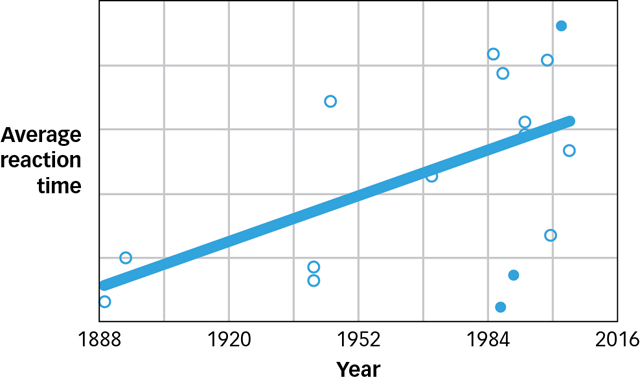
Does this mean that we are innately less clever and that this fact is being obscured by the big IQ boost we get from our environments? Maybe, but maybe not. There are problems with using old data that were collected under unknown circumstances, and the participants in older studies were probably not representative of the entire population. Nonetheless, the finding is provocative because it suggests that modern life may be an even more powerful cognitive enhancer than we realize.
10.4.2.2 Education
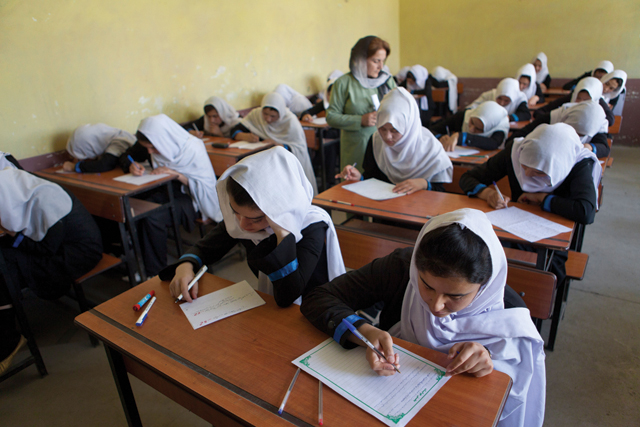
Alfred Binet believed that if poverty was intelligence’s enemy, then education was its friend. And he was right about that too. The correlation between the amount of formal education a person receives and his or her intelligence is quite large, somewhere in the range of r = 0.55 − 0.90 (Ceci, 1991; Neisser et al., 1996). One reason why this correlation is so large is that smart people tend to stay in school, but the other reason is that school makes people smarter (Ceci & Williams, 1997). When schooling is delayed because of war, political strife, or the simple lack of qualified teachers, children show a measurable decline in intelligence (Nisbett, 2009). Indeed, in places where children born in the first 9 months of a calendar year typically start school an entire year earlier than those born in the last 3 months of the same year, people with late birthdays tend to have lower intelligence test scores than people with early birthdays (Baltes & Reinert, 1969).
Does this mean that anyone can become a genius just by showing up for class? Unfortunately not. Although education reliably increases intelligence, its impact is small, and some studies suggest that it tends to enhance test-
415
10.4.3 Genes and Environments

Both genes and environment influence intelligence. But that should not lead you to think of genes and environments as two separate ingredients that are somehow blended together like flour and sugar in a recipe for IQ. The fact is that genes and environments interact in complex ways that make the distinction between them a bit murky.
How might genes exert their influence on intelligence?
For example, imagine a gene that made people enjoy the smell of library dust or that made them unusually sensitive to the glare produced by television sets. People who had such a gene might well read more books and thus end up being smarter. Would their increased intelligence be due to their genes or to their environments? Well, if they had not had those genes, then they would not have gone to the library, but if they had not gone to the library, then they would not have gotten smarter. The fact is that genes can exert some of their most powerful influences not by changing the structure of a person’s brain, but by changing the person’s environment (Dickens & Flynn, 2001; Nisbett, 2009; Plomin et al., 2001). A gene that made someone sociable might lead her to have good relationships with peers, which might lead her to stay in school longer, which might lead her to become smarter. Would we call such a gene a “sociability gene” or an “intelligence gene” (Posthuma & de Geus, 2006)? Would we attribute that person’s intelligence to her genes or to the environment that her genes enabled her to create? As these questions suggest, genes and environments are not independent influences on intelligence, and the clear difference between nature and nurture is not as clear as it might first appear.
Both genes and environments influence intelligence.
The heritability coefficient (h2) tells us what portion of the difference among people in a given population is attributable to differences in their genes.
Relative intelligence is generally stable over time, but absolute intelligence changes.
Socioeconomic status (SES) has a powerful influence on intelligence, and education has a moderate influence.
416